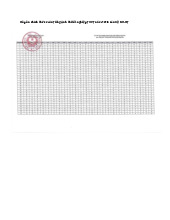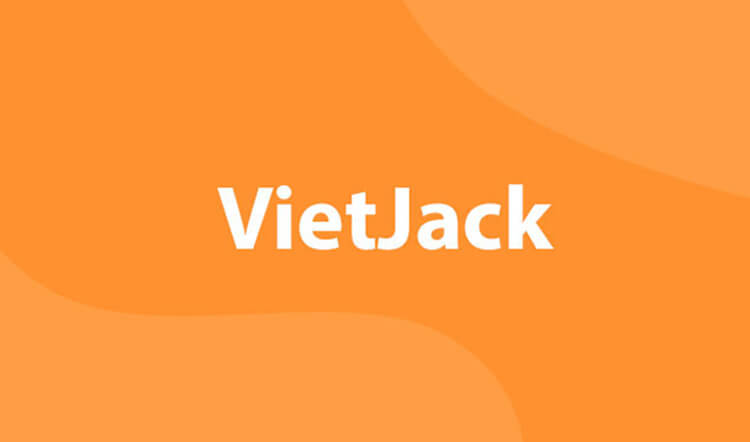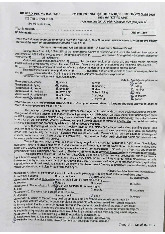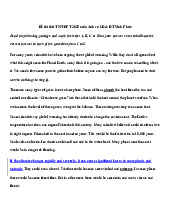

















Preview text:
Đề thi thử sở GD&ĐT Quảng Nam môn tiếng Anh năm 2025
Read the following advertisement and mark the letter A, B, C or D on your answer
sheet to indicate the option that best fits each of the numbered blanks from 1 to 6.
GET READY FOR YOUR CENTER CAREER!
Are you looking for a fresh start in the job market? The city of Greenfield is
excited to announce its 15th annual (1) ______! Over the past few months, we have
worked hard (2) ______the quality of our training, so that citizens can get the skills
(3)______. Starting next Monday, this six-month course will teach you (4) ______skills
in areas such as computer use, customer service and basic accounting. With hands-on
practice, you'll (5) ______confidence and be ready to take on new opportunities.
You don't want to miss this chance, do you? Sign (6) ______ today and take the
first step toward a brighter future!
(Adapted fromi-LSWPractice Tests)
Question 1: A. training vocational course B. vocational training course C. vocational course training D. course vocational training
Question 2: A. to improve B. improving C. to improving D. improve
Question 3: A. which really needs B. really needing C. they really need D. are really needed
Question 4: A. practical B. practicality C. practically D. practice Question 5: A. feel B. use C. share D. gain Question 6: A. up B. at C. out D. in
Read the following leaflet and mark the letter A, B, C or D on your answer sheet to
indicate the option that best fits each of the numbered blanks from 7 to 12. WATER CONSERVATION
So what if people save a lot of water- we’ve got (7) ______, haven’t we? Well, we
may have a lot of sea water, but we are using fresh water faster than nature can replace it.
So instead we are forced to recycle waste water, clean it and then (8) ______it into
people’s homes. That process requires a lot of energy- running a tap for five minutes uses
the same energy as burning a 60-watt light bulb for fourteen hours and a lot of money. (9)
______this, when underground natural water reservoirs get low on water, they can
become contaminated with high concentrations of natural (10) ______ like arsenic, or
man-made chemicals from the ground. To (11) ______this, we need to keep these
reservoirs well-stocked. (12) ______way to prevent this is by implementing stricter water
usage policies. So conserve water and you will save money and the planet.
(Adapted from Life by John Hughes) Question 7: A. enough B. little C. toomany D. a little
Question 8: A. transport B. pipe C. store D. direct
Question 9: A. In terms of B. In addition to C. By means of D. In spite of
Question 10: A. resources B. wonders C. disasters D. minerals
Question 11: A. keep away B. take in C. put on D. head off
Question 12: A. The other B. Others C. The others D. Another
Mark the letter A, B, C or D on your answer sheet to indicate the best arrangement of
utterances or sentences to make a meaningful exchange or text in each of the
following questions from 13 to 17. Question 13: Dear Minh,
a. These activities not only make our school a better place but also help us
become more responsible for protecting the environment.
b. Hope you're doing well! In your last letter, you asked me about what our
school does to protect the environment.
c. We also encourage everyone to save energy by turning off lights and fans when they’re not needed.
d. Besides, we often organize environmental campaigns where students
make posters and give presentations about eco-friendly habits.
e. Well, we have a lot of activities to keep our school green and clean. For
example, we plant trees and have a composting system to reduce waste. Best, Tuan
(Adapted from i-Learn Smart World) A. a–d–b–c–e B. c–a–d–b–e C. d–b–a–c–e D. b–e–c– d–a
Question 14: a. Furthermore, prolonged bullying can negatively impact a person's future
success, leading to difficulties in education, career, and social interactions.
b. Schools, parents, and communities must work together to prevent
bullying by promoting awareness and implementing strict policies.
c. Bullying is a serious issue that negatively affects individuals’ mental
health, self-esteem, and academic performance.
d. Victims of bullying often experience anxiety, depression, and social
isolation, which can have long-term consequences.
e. Addressing bullying effectively not only protects individuals but also
helps create a safer and more inclusive environment.
(Adapted from https://bestdaypsych.com) A. c–a–d–b–e B. c–d–a–b–e C. c–b–a–e–d D. c–a–b– e–d
Question 15: a. Michelle: What are you hungry for?
b. Michelle: Ah, here comes the shuttle bus. Come on, let's move.
c. Michelle: The show is tomorrow. But today we need to check our booth
and make sure all our products are in good condition.
d. Dan: A hot dog, the works, would be great.
e. Dan: Yes, Ma'am. Let's go. Maybe we can grab a bite on the way to the fair. I'm hungry.
(Adapted from https://englishdaily626.com) A. c–e–a–d–b B. c–d –a–e –b C. a–d–b–e–c D. b–d–a– e–c
Question 16: a. Additionally, maintain eye contact and nod occasionally to show that
you are engaged in the conversation.
b. Good communication etiquette is essential for building strong
relationships and showing respect to others.
c. If you need to interrupt, do so politely by saying, "Excuse me," and wait for the right moment to speak.
d. It is important to listen actively and avoid interrupting while someone else is speaking.
e. Lastly, be mindful of your tone and volume to ensure that your message is received positively.
(Adapted from https://www.montclair.edu) A. a–b–c–d–e B. a–d–c–b–e C. b–d–c–a–e D. b–c–a– d–e
Question 17: a. John: Hey, Sarah! Thanks a lot. You look fantastic too! Have you traveled recently?
b. Sarah: Hey, John! It's been forever! You look awesome!
c. Sarah: Yes, I’ve just come back from Japan. It was such an amazing trip!
(Adapted from https://englishdaily626.com) A. a–c–b B. c–a–b C. a–b–c D. b–a–c
Read the following passage and mark the letter A, B, C or D on your answer sheet to
indicate the option that best fits each of the numbered blanks from 18 to 22.
Artificial Intelligence (AI) has the potential to address some of the biggest
challenges in education today, innovate teaching and learning practices, and accelerate
progress towards SDG 4. However, rapid technological developments inevitably bring
multiple risks and challenges, (18)______. UNESCO is committed to supporting Member
States to harness the potential of AI technologies for achieving the Education 2030 Agenda. (19) ______.
UNESCO's mandate calls for a human-centered approach to AI, focusing on AI's
role in reducing gaps in access to knowledge, research, and cultural diversity, while
ensuring AI doesn't increase the technological divide within and between countries.
(20)______.Within the framework of the Beijing Consensus, Guidance for Policy-makers
was designed to help governments prepare for the use of AI in education.AI competency
frameworks (21) ______. These frameworks serve as essential tools for preparing future
generations with the digital literacy and ethical awareness needed in an AI-driven world.
UNESCO’s vision of “AI for all” is rooted in global collaboration and inclusive innovation. (22)______. (Adapted from Unesco) Question 18:
A. of which policy makers, regulations, as well as industry leaders and experts
B. which policy makers and regulations are struggling to address
C. that policy makers and regulations are struggling to successfully address
D. policy makers and regulations are struggling to address effectively Question 19:
A. Besides, the organisation emphasizes the importance of AI's role in promoting
customer service experiences and user satisfaction
B. Meanwhile, the organisation focuses on integrating AI to create personalized
learning platforms aimed at maximizing student engagement
C. In addition, the organisation advocates for AI applications in urban planning,
infrastructure development and smart city initiatives
D. At the same time, the organisation ensures that AI application in educational
contexts is guided by the core principles of inclusion and equity Question 20:
A. Its aim is to prevent AI from reinforcing global inequities
B. The conversation mostly ignores cultural diversity
C. It also ensures that AI supports only economic goals
D. It leads UNESCO to focus on AI hardware production Question 21:
A. were also published by UNESCO to guide countries in supporting students and
teachers to understand the potential as well as risks of AI
B. of which the purpose is to guide countries in supporting students and teachers to
understand the potential as well as risks of AI
C. that also published by UNESCO to guide countries in supporting students and
teachers to understand the potential as well as risks of AI
D. whose purpose is to guide countries in supporting students and teachers to
understand the potential as well as risks of AI Question 22:
A. The vision promotes advanced research and scientific progress over inclusive learning
B. It prioritizes commercial use of AI tools in educational institutions across developing nations
C. It excludes small disadvantaged nations that lack AI infrastructure and well- equipped facilities
D. This vision ensures equal and meaningful access to the benefits of AI for everyone
Read the following passage and mark the letter A, B, C, or D on your answer sheet to
indicate the best answer to each of the following questions from 23 to 30.
Is there a right way to bring up children? Some parents read guides to find an
answer, many just follow their instinct. Whatever they do, a doubt always remains: could I have done a better job?
A recent contribution to the subject is Amy Chua's controversialbook Battle
Hymn of the Tiger Mother, which describes the approach to child-rearing of an ambitious
Chinese parent living in the west. According to Chua, western mothers are far too soft on
their children. She says they are always praising their children for every effort theymake,
even if the result is coming last in a race or playing a piano piece badly. These are the
kind of parents who will give in to their children's demands to go out and play rather than
do their homework, if they protest loud enough.
The tiger mother method is very different and the key is total control. Tiger
mothers will accept nothing less than 'A' grades in every subject - failure to achieve these
is just proof that they have not worked hard enough. They will encourage not with praise
and reward, but by punishing and shaming. Chua told her own daughter that she would
take her doll's house to a charity shop if she failed to master a difficult piano piece. She
even rejected a homemade birthday card from her daughter Sophia because she had drawn it in a hurry.
But that highlights another difference, says Chua, which is directness and honesty.
A tiger mother will not hesitate to tell their child that they are lazy, whereas western
parents are always telling their children not to worry, that they will do better next time,
even if they think they have been lazy. The constant nagging of the tiger mother, the
banning of TV and computer games seems harsh, but perhaps it works. Chua's
children have not rebelled, and they don't resenttheir strict upbringing. They regularly get
the top grades at school and are proficient at violin and piano - stereotypical symbols of
success, critics would say. By contrast, children with more freedom and more laid-back
parents will often lack self-discipline and will fail to push themselves to achieve more.
(Adapted from Life by Paul Dummett, John Hughes and Helen Stephenson)
Question 23: The word controversial in paragraph 2 is OPPOSITE in meaning to ______. A. highly disputed B. openly questioned C. strongly debated D. widely accepted
Question 24: The word theyin paragraph 2 refers to _______. A. demands B. westernmothers C. children D. Chineseparents
Question 25: The word laid-back in the passage could be best replaced by ______. A. strict B. ambitious C. relaxed D. controlling
Question 26: Which of the following best paraphrases the underlined sentence in paragraph 4?
A. Although tiger mothers seem very strict, their approach might be effective.
B. Tiger mothers do not allow TV or computer games, which makes children hate them.
C. Tiger mothers are too strict, and their method does not work at all.
D. Children who do not watch TV or play games are more intelligent.
Question 27: In which paragraph does the writer mention how Amy Chua applied
strict parenting rules to her own children? A. Paragraph 1 B. Paragraph 2 C. Paragraph 4 D. Paragraph 3
Question 28: In which paragraph does the writer emphasize the value of being
straightforward in the tiger mother’s approach? A. Paragraph 2 B. Paragraph 3 C. Paragraph 4 D. Paragraph 1
Question 29: Which of the following is NOT TRUE about tiger mothers?
A. They demand high academic achievement from their children.
B. They believe strict discipline leads to success.
C. They often encourage their children to pursue social activities.
D. They use criticism as a form of motivation.
Question 30: Which of the following is NOT mentioned as a characteristic of tiger mothers?
A. They are direct and honest with their children.
B. They accept nothing less than top grades.
C. They encourage their children with rewards and praise.
D. They use punishment and shaming to motivate their children.
Read the following passage and mark the letter A, B, C or D on your answer sheet to
indicate the best answer to each of the following questionsfrom 31 to 40.
‘Happiness is not having what you want but wanting what you have,’ according to
James Stewart. Although scientists now understand the roots of depression more clearly
than they used to, happiness still remains a mystery. Recently, however, some interesting discoveries have been made.
Those who say they are happy, for example, tend to be less self-centered, less
hostile and abusive, and are less prone to disease and general ill health. Interestingly, the
affluent are not notably happier than their less-well-off counterparts, and seemingly, no
particular time of life is significantly happier than any other. Even though some people
see life as a tragedy, when questioned, most people said they were generally happy -
painting a much rosier picture regarding people's general moods and dispositions.
Research has shown that people have two basic reward centres in their brains that
are stimulated by two different chemicals which cause happiness. The first, dopamine, is
triggered by activities like exercise, relaxation and the quieter pleasures. The second
comprises a set of adrenaline-type chemicals which are triggered by exciting or
frightening activities. Dopamine provokes a response of passive happiness, while the
second set of chemicals provokes a high-energy state of happiness, the feeling one might
get from public speaking or mountain climbing.
[I] While understanding the chemical process behind happiness is important, it
does not explain why only some people are consistently happy. [II] One of the reasons
we have such a problem with happiness is that many confuse it with a life untouched by
anxiety, rage, doubt and sadness. [III] The belief that happiness means that nothing ever
goes wrong is naive; in order to be happy, we must know not how to avoid disturbing
events, but how to deal with them. [IV]
The key to coping with life's unpleasant aspects, while remaining content, comes
from an everyday practice which Mihaly Csikszentimihalyi calls "the flow". He describes
"the flow" as the state one is in when doing something completely absorbing. It comes
when one is pushed right up to the limit of one's ability, but not beyond it. "People can
get a feeling of flow from dangerous sports like mountain climbing or driving fast," he
says "but it can also come from something relaxing like painting or reading a good book".
The point is that it's an activity you do for the pleasure of doing it. You are not looking
for praise or reward. What is important, is to keep your brain busy if you want to be
happy. The professor explains: "If you leave someone on their own with nothing specific
to do, most of their thoughts will be worries." People tend to think about all the things
they want and haven't got rather than how good their life is. It seems the key to
happiness lies in having an active and challenging lifestyle.
The scientific study of happiness will help us understand how to build a world that
improves human well-being and self-esteem, and how to get the most satisfaction from their goals and circumstances.
(Extracted from Mission FCE by Jenny Dooley and Virginia Evans)
Question 31: The wordthey in paragraph 1 refers to_______. A. mysteries B. roots C. discoveries D. scientists
Question 32: The phrasethe affluentin paragraph 2 could be best replaced by_______. A. the wealthy B. the elderly C. the educated D. the poor
Question 33: Which of the following best summarises paragraph 3?
A. Passive and high-energy happiness come from different chemicals, with each suited
for different types of activities.
B. Happiness is triggered by either passive pleasures from dopamine or active excitement from adrenaline.
C. Dopamine and adrenaline both play roles in happiness but are triggered by different types of activities.
D. Different brain chemicals cause different types of happiness: dopamine leads to
relaxation, while adrenaline leads to excitement.
Question 34: Where in paragraph 4 does the following sentence best fit?
The answer may lie in people's perceptions of happiness. A. [III] B. [I] C. [IV] D. [II]
Question 35: Which of the following statements is TRUE according to the passage?
A. Happiness is achieved by eliminating all negative emotions and life disturbances.
B. Perception of happiness can vary greatly between individuals.
C. A misconception about happiness implies never having problems.
D. There is a clear link between wealth and long-term happiness.
Question 36: The wordcontentin paragraph 5 is OPPOSITE in meaning to_______. A. peaceful B. dissatisfied C. relaxed D. happy
Question 37: According to paragraph 5, which of the following is NOT a characteristic of‘the flow’?
A. It occurs when someone is fully absorbed in an activity.
B. It happens when someone is pushed beyond their ability.
C. It is something people do for pleasure, not for rewards.
D. It can be experienced through both relaxing and thrilling activities.
Question 38: Which of the following best paraphrases the underlined sentence in paragraph 5?
A. Those who own many things tend to feel much happier in life.
B. Thinking about unfulfilled desires instead of real life is natural.
C. People are always satisfied with the things they already own.
D. People focus more on what they lack than on what they have.
Question 39: Which of the following can be inferred from the passage?
A. Both dopamine and adrenaline are involved in a state of happiness that is driven by social recognition.
B. Happiness is equally dependent on external circumstances as well as an individual’s
approach to life’s challenges.
C. Acquiring wealth and material goods are regarded as the primary sources of happiness.
D. Happiness is a multi-faceted concept with an emphasis on internal psychological
processes to shape positive states.
Question 40: Which of the following best summarises the passage?
A. No specific stage of life is notably happier than another, with resilience in the face
of hardship being considered the main factor in achieving “the flow”.
B. Happiness, driven by two brain chemicals, emerges from handling life’s obstacles
and engaging in activities that stretch our limits.
C. The majority of people report being generally happy, highlighting overcoming
difficulties in life as the key to achieving satisfaction.
D. Happiness is connected to two brain systems and is fostered by maintaining a naive
attitude towards life difficulties. ĐÁP ÁN 1 2 3 4 5 6 7 8 9 10 B A C A D A A B B D 11 12 13 14 15 16 17 18 19 20 D D D B A C D B D A 21 22 23 24 25 26 27 28 29 30 A D D C C A D C C C 31 32 33 34 35 36 37 38 39 40 D A C D C B B D D B




